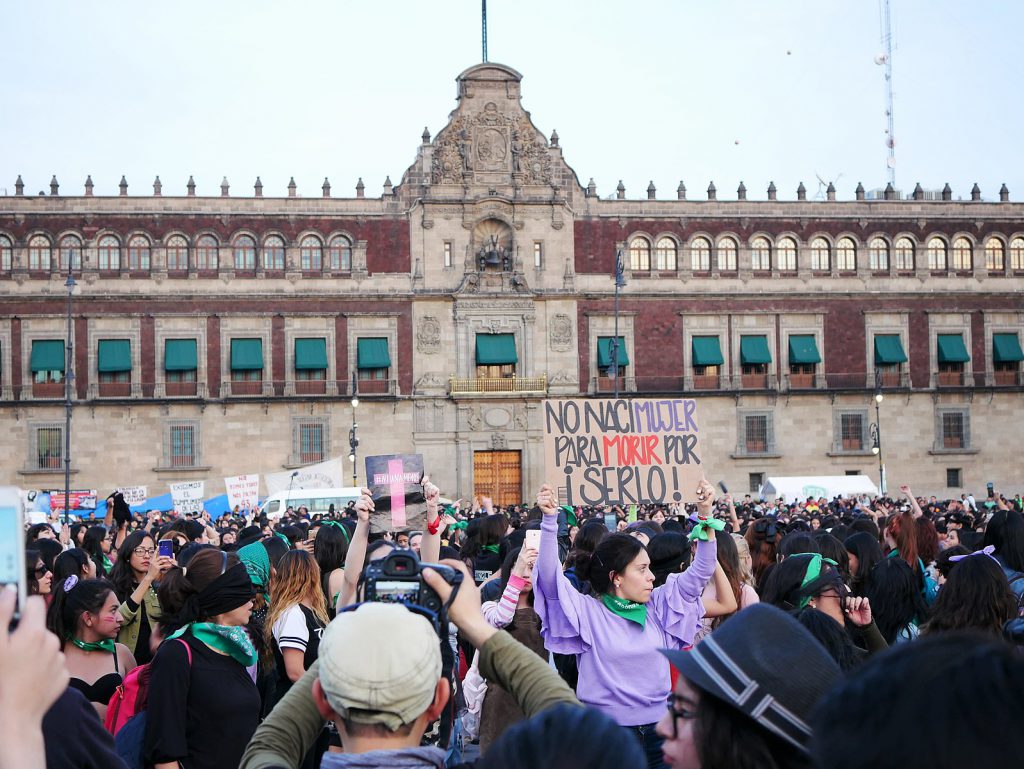
It was Valentine’s Day in Mexico City, a holiday that usually radiates love and unity, expressed through bouquets of bright flowers, romantic cards, and all things red. This year, 2020, about 200 women gathered and spent the day demonstrating their hatred for “femicide,” the killing of a woman on account of her gender, while displaying their love for those lost to the misogynistic-rooted issue.1 Although these women refused to celebrate Valentine’s Day in its stereotypical way, they embraced the day’s meaning to showcase a different kind of love, one that is shared between mothers, daughters, sisters, and friends. These connections not only tied the protesters to the thousands of victims, but to each other as well, for each of them are at risk of dying by the hands of femicide.2 As the mass of marchers made their way to the National Palace, Valentine’s Day decorations could still be seen. Light flowers and large posters, covered in messages of love, were carried as protesters paid respect to all femicide victims.3 These tokens clashed against the crowd, as many coated themselves in black clothing and purple pieces either on their hands, face, or body, representing domestic abuse that is often related to femicide cases. While marching down the dark paved streets, the women’s voices filled the air with explosive chants, such as “Ni una menos!” which translates to “Not one murder more!”4

Once they reached the National Palace, the steady atmosphere faded as flowers were traded for spray paint cans and victims’ photographs were replaced by paint-filled balloons.5 Behind the palace’s tall, mahogany doors was the President of Mexico, Andrés Manuel López Obrador, hosting a conference about Mexico’s femicide issue. He hoped to reassure the public by stating that, “The government I represent will always take care of ensuring the safety of women.” However, the protesters outside began arguing otherwise.6 The palace doors soon became the activists’ canvas, where they illustrated emotions brought on by years of persecution and violence. Swelled balloons were launched first, causing blood-red paint to splatter everywhere, resembling the brutal crime scene found only five days earlier.7

Ingrid Escamilla was only twenty-five years old when her life was viciously stolen from her. She came from a family of six, including her four sisters, one being her twin, and her devoted father, who continued to raise them after their mother left. Sadly, he had passed away about four years earlier, but Ingrid was known to cherish him as she spoke about him dearly at every opportunity given. Despite Ingrid’s heavy life obstacles, she was viewed as a noble-hearted individual who always had new goals she strove to achieve. Her noted traits were especially shown through her academic career, out of which she obtained her master’s degree in Tourism Business Administration. Before she became a victim, Ingrid Escamilla was a successful woman who made an effort to enjoy her passions, such as family, animals, music, and traveling. Her bright future was erased from the world on February 9, 2020, when Erick Francisco, her partner, fifty-six years old, murdered her in her own home.8 The apartment building was located on Tamango Street, in the Vallejo Colony. On the fifth floor, behind the white and pale blue walls, Ingrid Escamilla’s bloodied body was found. It is believed that Ingrid and Erick had gotten into an argument that morning or late in the evening on February 8. When being interviewed by the police, Erick claimed that he had consumed several alcoholic drinks, but that didn’t lessen the ruthlessness of his actions. Erick recounted the story, explaining that the couple’s altercation took place in the kitchen, which is where he obtained the knife he used to commit several inhumane actions. He reportedly told police that he first buried the knife within Ingrid, before skinning and disemboweling her. Not only did Erick continue to violate Ingrid’s body after her death, but he disrespected her remains when he decided to hide the evidence by flushing her organs and skinned pieces down the toilet. Out of fear, and possibly guilt, Erick called his ex-wife to disclose the horrid killing he had executed. Fortunately, his ex-wife informed police, allowing them to plan the successful arrest of Erick. Shortly after receiving her call, police made their way to the crime scene. Stepping into the kitchen, Ingrid and Erick were seen on the floor, surrounded by a pool of blood. Shirtless, disheveled, and blotched with his partner’s blood, Erick was kneeling while still holding the dirty knife in his hand. Once he was formally arrested, police questioned Erick’s reasoning behind throwing his partner’s remains away in such a cruel manner. The murderer responded with, “I didn’t want anyone to notice.”9 Ironically enough, Erick’s fifteen-year-old autistic son, Rodolfo, reportedly witnessed the killing. Although Ingrid’s death was shocking, close friends of hers knew of Erick’s violent tendencies. They claimed that in 2019, Ingrid had begun to file a report on Erick, but changed her mind and regrettably gave him a second chance. Sadly, her community also knew of Ingrid’s undeserved abuse, for Erick would insult and beat her frequently.10

As the red paint dripped down the palace doors, Ingrid’s grisly case was not the only one being illustrated; it symbolized all women’s blood that’s been shed in Mexico. Layered over the chaotic paint, protesters spray-painted statements. In all black, capital letters, sitting at the bottom of the Palace doors, was written “ESTADO FEMINIDA”, translating to “FEMICIDE STATE”.11 On another pair of doors, “INGRID” was sprayed in pink, reemphasizing that her case was not a typical homicide, but one that matched many other women’s cases, a femicide.12 The palace doors and nearby walls were now covered in a disorganized series of statements, but one protester defended their work. She stood in front of a vandalized wall and stated, “I’m sure people will say ‘look at these crazy women, spray-painting this historic door from the revolution,’ but what they should do is read what we’ve written. How many women have been killed, how many have been raped, how many are being discriminated, that’s what really matters.”13
Her words echoed the thoughts of all other protesters, for most cases in Mexico are not investigated as a femicide. Fortunately Ingrid’s case was, but statistics show that out of every five homicide cases, only one is treated as a femicide. When one realizes that an average of ten women are killed in Mexico every day, that number becomes clearly indefensible.14 Numbers will only continue increasing, as shown in data from 2015 to 2019, where a 111% increase of murders against women in Mexico was calculated. Holding the highest record was the year 2018, for it recorded 3,752 killings of women. Although Mexico was one of the first countries to classify femicide as its own crime, women’s lives are still being taken from them, viciously and without valid reasoning.15 A twenty-one year old student, named Jocelyn, displayed the reality behind the numerical data, as she admitted, “I’m afraid to go out on the street alone. Violence against women has normalized in Mexico.” Despite the widespread alarm felt by Mexican women daily, there are still those who label femicide as insignificant, or a foolish product of women’s imagination. Shockingly enough, some of those individuals are found in positions of power, such as Alejandro Gertz Manero, the head of the Attorney General’s Office of the Republic. During a private meeting, held at the beginning of February, Manero had proposed the abolishment of femicide’s criminal title and replacing it with investigations similar to a murder that simply involved aggravated assault. Although this change is very unlikely to occur, the suggestion in itself reflects the lack of urgency femicide is still viewed with. Edith López, a feminist lawyer, explains that femicide’s presence should stay in the legal field, not only to display the severity of the issue, but to stand as a symbol for the government’s compassion towards its women’s horrifying, new normal. The government shouldn’t be trying to remove femicide’s distinct title out of ignorance, or annoyance; instead, Mexico should be working to prevent the mass amount of murders involving women. Only until femicide is nonexistent, if it it ever reaches extinction, should the title be abolished. Until then, Mexican women will have to continue enduring more pain and more violence, which will leave them with permanent, physical and emotional scars.16
Once the National Palace’s doors were covered in expressions of betrayal, fear, and despair, the protesters began moving to their next destination. Heavy footsteps and the words “THE PRESS IS COMPLICIT” filled the streets where the newspaper La Prensa’s offices were stationed. Soon after they arrived, the women began burning newspaper articles that contained horrifying photos of Ingrid’s mutilated body.17 In order to emphasize their disapproval for the newspaper’s use of Ingrid’s awful fate, some women attacked a company-owned van. As women crowded the white van, some spray-painted the side of it in black, purple, and pink, while those watching supported them with shouts resembling a battle cry. Those in front of the van cracked the windshield, and even managed to smash it into the vehicle, with the help of a hammer and long metal rod. One woman even made an effort to burn the van, as she held a lighter to the van’s right-side door.18 The anger displayed toward La Prensa was rooted in the newspaper’s publishing of Ingrid Escamilla’s leaked crime scene photo, which they placed directly on the cover. Another media company called Pasala, also published the gruesome photo, and even paired it with an apathetic title, “It was cupid’s fault.”19 In doing so, these companies gave several social media platforms access to the horrifying photo, which soon circulated the internet. In the public’s opinion, and for Ingrid’s family, Ingrid was victimized twice, once in life and once in death. Only until a plan was proposed to post photos of beautiful, innocent objects with Ingrid Escamilla’s name attached, did the attention of Ingrid’s violated body fade.20 A protester exposed the lack of sympathy expressed by media towards Ingrid’s case, when she bluntly demanded, “Before you publish a photograph, before you write a story, think, think that this could’ve been your sister, that this could’ve been your daughter, that this could’ve been your mother.”21 The truth is, these women are someone’s sister, daughter, or mother. If that isn’t enough, the fact that they are human beings gives them the undeniable right to live. Yet, there are numerous murders against women in Mexico. At the rate they are occurring, these cases shouldn’t be labeled as regular homicides, but due to the lack of seriousness that femicide is viewed with, they are. “It’s not just Ingrid. There are thousands of femicides,” says one mother, named Ms. Guerrero, whose daughter was murdered in 2017.22 These protesters marched and defended Ingrid’s case, but they equally demanded recognition of Mexico’s great femicide issue. Women would continue to let their voices be heard in protests that were scheduled for the following days.23 Although Ingrid’s case was not the first femicide committed in Mexico, it was one of the cruelest, igniting Mexican women’s sense of betrayal and their desire to obtain justice for all victims before her. Mexican women, in Ms. Guerrero’s words, have been filled with anger and rage, bringing them no choice but to protect themselves from the horrid reality of Mexico’s femicide curse.24
I would like to thank the following individuals for helping me during the early stages of this project, for they made the process a memorable one. I am grateful for Dr. Sperling and Dr. Duesterhoeft’s advice, which enabled me to pursue such a topic with passion. I am also indebted to Daniela Durán for her guidance in the project’s proposal stage, as it proved to be very fitting to the story I wanted to tell. I’d also like to express my gratitude for Christopher Hohman’s review of my outline, since it aided me in organizing my article’s events. Lastly, I’d like to thank Dr. Whitener for giving me such a wonderful opportunity, not only to grow as a writer but to bring awareness to an issue that is being neglected.
- Daina Beth Solomon and Josue Gonzalez, “Ingrid Escamilla: Hundreds protest rise of femicide in Mexico after woman’s brutal killing; Local newspaper targeted over printing gruesome photograph of corpse,” The Independent (United Kingdom), February 15, 2020. ↵
- “Ingrid was 25 years old, a master’s degree and loved to travel: this is how she was in life the young victim of femicide who shocked Mexico,” CE Noticias Financieras English, February 11, 2020. ↵
- Al Jazeera English, “Mexican women protest after gruesome killing of Ingrid Escamilla,” Youtube video, (2020): https://www.youtube.com/watch?v=_DBLqGy91Qk. ↵
- “Mexico women protest after gruesome killing of Ingrid Escamilla,” ALJAZEERA, (2020): https://www.aljazeera.com/news/2020/02/mexico-women-protest-gruesome-killing-ingrid-escamilla-200214200645471.html. ↵
- “‘It fills us with rage’: Mexican Activists protest femicide at national palace,” The Guardian, (2020): https://www.theguardian.com/world/2020/feb/14/mexico-femicide-protest-ingrid-escamilla. ↵
- “Mexico women protest after gruesome killing of Ingrid Escamilla,” ALJAZEERA, (2020): https://www.aljazeera.com/news/2020/02/mexico-women-protest-gruesome-killing-ingrid-escamilla-200214200645471.html. ↵
- Al Jazeera English, “Mexican women protest after gruesome killing of Ingrid Escamilla,” Youtube video, (2020): https://www.youtube.com/watch?v=_DBLqGy91Qk. ↵
- “Ingrid was 25 years old, a master’s degree and loved to travel: this is how she was in life the young victim of femicide who shocked Mexico,” CE Noticias FinancierasEnglish, February 11, 2020. ↵
- “This we know about the femicide of Ingrid Escamilla at GAM,” CE Noticias Financieras English, February 11, 2020. ↵
- “Erick Francisco “N” alleged effocide of Ingrid Escamilla was linked to the process,” CE Noticias FinancierasEnglish, February 12, 2020. ↵
- Ellen Cranley, “Photos show how fiery protesters using fake blood took over Mexico City in response to the rise of brutal killings of women,” Insider, (2020): https://www.insider.com/mexico-city-protests-responding-to-rise-of-killings-of-women-2020-2. ↵
- “‘It fills us with rage’: Mexican Activists protest femicide at national palace,” The Guardian, (2020): https://www.theguardian.com/world/2020/feb/14/mexico-femicide-protest-ingrid-escamilla. ↵
- Al Jazeera English, “Mexican women protest after gruesome killing of Ingrid Escamilla,” Youtube video, (2020): https://www.youtube.com/watch?v=_DBLqGy91Qk. ↵
- “‘It fills us with rage’: Mexican Activists protest femicide at national palace,” The Guardian, (2020): https://www.theguardian.com/world/2020/feb/14/mexico-femicide-protest-ingrid-escamilla. ↵
- “Ingrid was 25 years old, a master’s degree and loved to travel: this is how she was in life the young victim of femicide who shocked Mexico,” CE Noticias FinancierasEnglish, February 11, 2020. ↵
- “Femicide: the crime that has exposed the government’s inability to react,” CE Noticias Financieras English, February 16, 2020. ↵
- Daina Beth Solomon, Josue Gonzalez, “Ingrid Escamilla: Hundreds protest rise of femicide in Mexico after woman’s brutal killing; Local newspaper targeted over printing gruesome photograph of corpse,” The Independent (United Kingdom), February 15, 2020. ↵
- No Comment TV, “Women in Mexico protest against grisly murder of Ingrid Escamilla,” Youtube video, (2020): https://www.youtube.com/watch?v=0_TBPlmnS-U. ↵
- Daina Beth Solomon, Josue Gonzalez, “Ingrid Escamilla: Hundreds protest rise of femicide in Mexico after woman’s brutal killing; Local newspaper targeted over printing gruesome photograph of corpse,” The Independent (United Kingdom), February 15, 2020. ↵
- “The inspiring images with which they recounted Ingrid Escamilla, victim of femicide,” CE Noticias Financieras English, February 13, 2020. ↵
- Al Jazeera English, “Mexican women protest after gruesome killing of Ingrid Escamilla,” Youtube video, (2020): https://www.youtube.com/watch?v=_DBLqGy91Qk. ↵
- Daina Beth Solomon, Josue Gonzalez, “Ingrid Escamilla: Hundreds protest rise of femicide in Mexico after woman’s brutal killing; Local newspaper targeted over printing gruesome photograph of corpse,” The Independent (United Kingdom), February 15, 2020. ↵
- “Women will march in Mexico in memory of Ingrid Escamilla,” CE Noticias Financieras English, February 14, 2020. ↵
- Daina Beth Solomon, Josue Gonzalez, “Ingrid Escamilla: Hundreds protest rise of femicide in Mexico after woman’s brutal killing; Local newspaper targeted over printing gruesome photograph of corpse,” The Independent (United Kingdom), February 15, 2020. ↵




48 comments
Alyssa Ramos
This was a well written article that described such a heartbreaking story. I heard a little about the movement through social media, but I did not know what it was fully about. It is empowering to see the people of Mexico standing up for these victims. Ingrid Escamilla did not deserve the treatment she received, nor did she deserve to have her life shortened because of her abusive husband. I really do not understand how someone can commit such horrible actions.
Donte Joseph
I had not known who Ingrid Escamilla was and I also did not know about the situation in Mexico, but I am glad that I had this article to explain to me the struggle and movement that is taking place. It is shame that the Mexican government has done little to nothing in order to help the situation, but I am glad that there are articles such as this that can explain the situation and draw attention in hopes that change comes forth.
Alexandria Wicker
This article and these stories are truly heartbreaking. But I will say that the article itself is very well written and it is very informative. It hurts my heart to read Ingrid’s story, but it also is so beautiful to see the people coming together to fight for justice for people that affected in this awful and horrible act. Her story is bone chilling and sickening to hear. I hope that woman that find themselves in situations like her find the justice that they deserve.
Erin Vento
I remember reading about both Ingrid Escamilla’s murder and the femicide protests earlier this year, but the details and statistics are so shocking and heartbreaking. I feel like lawmakers usually think that they can stop at acknowledging that something exists- even though everyone is aware of the problem- and then stop there. If the Mexican government acknowledges femicide as an issue and own category of crime, they should actively work to change those statistics. Good for the protesters who decided they wouldn’t sit by anymore.
Angela Perez
This article was heartbreaking to read but oddly empowering. The fact that nine women are killed daily in Mexico simply because they are women is disheartening. It is unbelievable that being of a specific gender places a target on your back for that reason alone. This movement in Mexico has drawn international attention and is only picking up speed. It is time that the Mexican government take responsibility for the role they play and have played in all of these deaths.
Keily Hart
This was a really well written and informative article. I did not know that this was even an issue facing women in Mexico, and I had never heard of Ingrid Escamilla. It is so saddening to hear of the loss of innocent life, but knowing that people are banding together to fight for justice for Ingrid Escamilla and others like her makes the story less of a tragedy.
Gabriela Herrera
Very saddening what our Mexican sisters have to endure because of the corrupt government. Violence has been normalized. For so long our ancestors turned a blind eye to the issue at hand and this must stop. We are the change.
Alexa Montelongo
I have been watching this movement unravel in Mexico, it’s time that these predators whether they be politicians, police officers, or militants pay for the price of femicides. I am tired of men getting to decide what they can do to our bodies when cases like this shed light that no girl and no woman is always responsible for the violent attacks men act upon us. #NiUnaMas is just the beginning of what the #Metoo movement led on here in the United States. It’s time this movement had begun and get noticed.
Shriji Lalji
Well written in depth article of the issue. This issue of femicides or just women being treated with not dignity is not only present in Mexico, it is seen throughout the world especially in poorer less developed areas. In fact just a few days ago there was a cruel gang rape of a low caste girl in India which sparked protests. Slowy people are becoming more aware of the issue. I found interesting how the women celebrated valentines day in a different manner.
Margaret Cavazos
This article offered an abundance of information on this very serious current issue. Although I had heard about what was happening, I had not heard about individual cases. The murder of Ingrid was horrific, as was the disrespect she faced after death. This article was well written and gave an in-depth view of the whole issue of femicide, from the protests, an individual case, and the government’s response. Very well written topic, and very respectful of the victims of femicide.